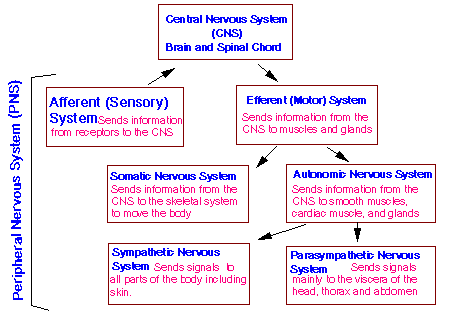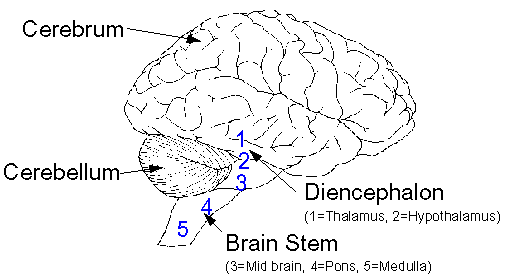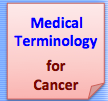Medical Terminology for Cancer
© Copyright 1996-2013
13: The Nervous System (Brain and nerves)
Contents
 Functions of the Nervous System
Functions of the Nervous System About Neurons
About Neurons Nerves, Neuroglia, and Ganglia
Nerves, Neuroglia, and Ganglia The Spinal Cord
The Spinal Cord  The Brian
The Brian The Sensory Systems
The Sensory Systems The Autonomic Nervous system (ANS)
The Autonomic Nervous system (ANS)  Roots, suffixes, and prefixes
Roots, suffixes, and prefixes Cancer Focus
Cancer Focus Related Abbreviations and Acronyms
Related Abbreviations and Acronyms Further Resources
Further ResourcesFunctions of the Nervous System
The complex activities of the body are controlled jointly by the Endocrine and the Nervous systems. As opposed to the Endocrine system the Nervous system has a more or less instant effect on the body via a complex network of nerves and control centres. The Central Nervous System (CNS) includes the brain and spinal cord, while Peripheral Nervous System (PNS) includes nerves connected to the spinal cord. The nervous system can be further divided into sub-systems, all of which are composed of neurons and connective tissue:

About Neurons
Neurons are specialised cells of the nervous system, they vary greatly in appearance and length, but contain a similar structure:- Axons are long nerve processes which carry nerve impulses from the Soma to other neurons, they vary in length but can become almost as long as half of the human body.
- The soma (body) of the neuron contains the nucleus which acts as the cell's control centre, these contain many small neurofibrils which project from the nucleus into the dendrites.
- Dendrites are short, thick processes which branch out of the soma in a tree like manor. They conduct nerve impulses to the soma.
The three categories of neurons:
- Afferent (Sensory) Neurons have the dendrites connected to receptors such as the eyes, ears etc. These receptors change the information they receive into electrical impulses that are transmitted to other neurons. In sensory neurons the axons are connected to other neurons.
- Efferent (Motor) Neurons have the dendrites connected to other neurons, the axons are connected to effectors. Effectors are either glands or a muscle cell that is the receiving end of the nerve impulse. The nerve, when excited will cause the effector to react (move, contract, or secrete etc).
- Internuncial Neurons have both the dendrites and the axons are connected to other neurons. They are sometimes referred to as connector neurons. Internuncial neurons are found throughout the body, but especially in the spinal cord and brain.
Properties and characteristics of Neurons:
- Normally the electrical impulses (messages) travel through a neuron in only one direction.
- The axon may be surrounded by a 'coat' of lipids (fats) and proteins known as the myelin sheath which acts as an insulator.
- Neurons are specialist cells that have lost the ability to reproduce themselves. Once the soma of a neuron has died the entire neuron dies, and can never be replaced.
- Repair of damaged neurons only occurs in myelinated neurons.
- white matter are coloured by myelin, consisting of many neurons supported by neuroglia.
- grey matter is soma and dendrites or bundles of unmyelinated axons and neuralgia.
Nerves, Neuroglia, and Ganglia
A nerve is a bundle of fibres (axons and/or dendrites) outside the CNS.
Neuroglia are cells of the nervous system that help protect and support it.
Ganglia are groups of nerve cell bodies lying outside the CNS.
The Spinal Cord
A spinal tract is a bundle of fibres in the CNS that travel long distances up or down the spinal cord. Ascending tracts carry impulses up the cord to the brain, while descending tracts carry impulses down the cord from the brain. Tracts run along the spinal canal inside the protective spinal column, conveying sensory and motor (movement ) information to and from the brain. Spinal meninges are tough tubes of tissue which protect the cord.
The Brian

The brain is highly complex, it contains about 1000 billion neurons, and weighs about 3 lbs in adults.
There are four main areas of the brain:
- The brain stem is at the base of the brain where it joins the spinal chord (contains the medulla, pons, and mid brain)
- The diencephalon is above the brain stem (contains the thalamus and hypothalamus)
- The cerebrum is above the diencephalon and forms the majority of the brain
- The cerebellum is the lower back of the brain
The brain has two hemispheres , there are functional differences, for example the left had side of the brain controls the right hand side of the body and visa versa (lateralisation).
Neurotransmitters are substances which excite or inhibit the neurons of the brain, facilitating communication between brain cells. These include endorphins, neuropeptides.
Cerebrospinal fluid circulates around the brain and spinal tracts to provide protection in addition to that provided by the meninges and protective bones of the spine and skull. A lumbar puncture (spinal tap) is where a needle is placed between the vertebra in the lower back. A sample of cerebrospinal fluid might be taken to see if cancerous cells have entered the CNS, or chemotherapy might be administrated to prevent or combat CNS involvement.
The Sensory Systems
A receptor or sense organ picks up stimulus and converts it into a nerve impulse. This impulse is then conducted along a neural pathway to the brain, where the signal is converted into a sensation. There are various receptors:
- Cutaneous (skin) senses. The skin contains specialist receptors for touch, pressure, vibration, hot, cold, and pain.
- Proprioceptive (muscle) sensations inform us of the activities and current posture of the muscles.
- Integrative sensations are not well defined but include memory, sleep, emotions etc.
- Olfactory sensations (smell). Olfactory neurons have dendrites that are connected to fine hairs in the nose that react to odours.
- Gustatory sensations (taste) there are about 2000 taste buds, mostly on the tongue and a few in the throat. Taste buds contain gustatory cells which contain sensitive hair like processes.
- Ophthalmic sensations (sight). The retina of the eye converts light into nerve impulses which are transmitted to the optic nerve. Retinoblastoma is a rare tumour in the cells of the retina.
- Auditory senses (hearing). Sound waves cause fine hairs in the inner ear to vibrate generating nerve impulses.
- Equilibrium (sense of balance) the ear also contains receptors that give a sense of static equilibrium (position of the head) and dynamic equilibrium (sudden movements).
The Autonomic Nervous system (ANS)
The nerves of the ANS activate the involuntary smooth muscles, cardiac muscles, and some glands.
Roots, suffixes, and prefixes
Most medical terms are comprised of a root word plus a suffix (word ending) and/or a prefix (beginning of the word). Here are some examples related to the Nervous System. For more details see Chapter 4: Understanding the Components of Medical Terminology
| component | meaning | example |
| ASTRO- | star | astrocyte = star shaped brain cell |
| CRANI- | skull | cranial radiation = radiation to the head |
| CEPHAL- | head | encephal = the brain, en(in) cephal (the head) |
| MENING- | membrane | meningitis = inflammation of the membranes of the spinal chord |
| NEUR- | nerve | neuroblast = an immature nerve cell |
| VENTRICULO- | cavity | ventricles are small cavities in the brain & spinal cord. Ventriculscopy = examination of ventricles |
| -MALACIA | softening | neuromalacia = morbid softening of the nerves |
| -GRAM | record | electroencephalogram (EEG) = brain scan |
Cancer Focus
- Overview of CNS Tumours
-
- Childhood CNS Tumours
- Childhood Brain tumours are the second most common type of childhood cancer. They are however a diverse group of different types of tumours. Classification of brain tumours is based on both histopathology
and location in the brain. For example, undifferentiated neuroectodermal tumours of the cerebellum are referred to as medulloblastomas, while tumours with similar histology in the
pineal region would be diagnosed as pineoblastomas. Patients may present with headaches, drowsiness, weakness, or vomiting caused by the pressure inside the skull caused by the growing tumour.
Medulloblastoma is nearly always found in children or young adults, 80% are found in children aged under 15. It can spread from the medulla (part of the brain stem) to the spine or to other parts of the body. Prognosis will depend on the child's age, how much of the tumour remains following surgery, and whether the cancer has metastasised.
Cerebellar astrocytoma arise in brain cells called astrocytes. Cerebellar astrocytoma is usually low grade (slow growing and non metastatic cells), while Cerebral astrocytoma can be malignant.
Brainstem gliomas are tumours arising in the mid brain, pons or medulla. They may grow rapidly or slowly, depending on the grade of the tumour, but overall have a less favourable prognosis compared to other tumours such as Cerebellar astrocytoma.
Other brain tumours include: Primitive neuroectodermal tumour (PNET), craniopharyngioma, intracranial germ cell tumour, pineal parenchymal tumour, and optic tract glioma.
 Internet Resources for Childhood Brain Tumours
Internet Resources for Childhood Brain Tumours
- Adult CNS Tumours
 Internet Resources for Brain Tumours
Internet Resources for Brain Tumours
- Cancers of the Eye
-
- Retinoblastoma
- Retinoblastoma is a rare tumour of the eye which develops in the cells of the retina, most patients are
under 5 years old. Sometimes only one eye is affected (unilateral-retinoblastoma ), but in about
two fifths of patients both eyes have the disease (bilateral-retinoblastoma ). Some cases are
known to be hereditary.
 Internet Resources for Retinoblastoma
Internet Resources for Retinoblastoma
- Intraocular Melanoma
- Intraocular melanoma is a rare cancer, in which malignant cells are found in the uvea (this is the part of the eye which contains the iris and other tissues). The uvea contains melanocytes which are cells that contain colour, intraocular melanoma occurs
when these cells become cancerous.
 Internet Resources for IntraOcular Melanoma
Internet Resources for IntraOcular Melanoma
- Neuroblastoma
- Neuroblastoma occurs most often in babies, very young children. It is a disease in which cancer cells are found in certain nerve cells in the body, it originates in the adrenal medulla or other sites of sympathetic nervous system tissue. The most common
site is the abdomen, either in the adrenal glands or around the spinal cord. The majority of patients present with metastatic disease. Age and stage are the main prognostic factors. Patients aged under one year at diagnosis have a more favourable
prognosis. Stage 4S are a special group of patients aged under one year whose neuroblastoma may undergo spontaneous regression (tumour disappears without treatment). Also patients aged under one a higher proportion of low stage patients compared to older
patients. There is an excess of males compared to females, there are a higher proportion of males in patients with less favourable sites and stage.
 Internet Resources for Neuroblastoma
Internet Resources for Neuroblastoma
Related Abbreviations and Acronyms
| ABTA | American Brain Tumour Association |
| BAER | Brainstem Auditory Evoked Responce |
| CNS | Central nervous system - the brain and spine |
| CSF | Cerebro spinal fluid |
| EANO | European Association for NeuroOncology |
| EEG | Electroencephalogram - brain scan |
| INFA | International Neurofibromatosis Association |
| INSS | International Neuroblastoma Staging System |
| LP | Lumbar puncture |
| NNFF | National Neurofibromatosis Foundation (USA) |
| NSE | Neuron-Specific Enolase - a neural marker |
| PNET | Primitive neuroectodermal tumour Context: CNS tumours |
| PNS | Peripheral nervous system - nervous system outside the brain and spine. |
Further Resources (3 links)
SEER, National Cancer Institute
Part of a SEER training module for cancer registry staff.
 Nervous System - Self Test questions
Nervous System - Self Test questions
WebAnatomy, University of Minnesota
Test your anatomy knowledge with these interactive questions. Includes different question types and answers.
 The Nervous System
The Nervous System
Paul Andersen
Paul Andersen begins this podcast with a discussion of brain lateralization and gives a brief demonstration of tests that were performed on split-brain individuals. He then discusses the major parts of a neuron and explains how action potentials are generated using voltage-gated ion channels. He explains how neurotransmitters transmit messages across a synapse and how these messages can be either inhibitory or excitatory.



This guide by Simon Cotterill
First created 4th March 1996
Last modified: 1st February 2014

 CancerIndex
CancerIndex